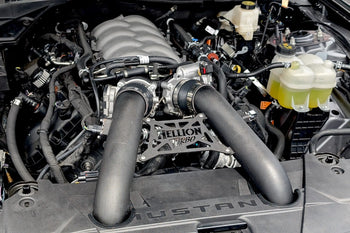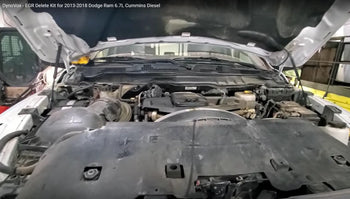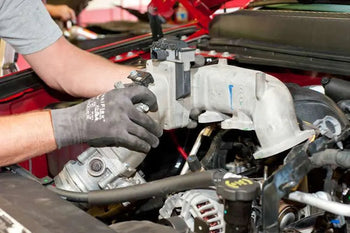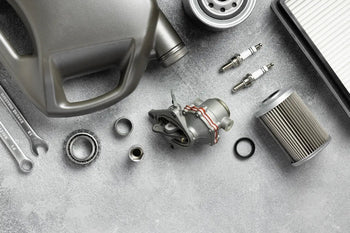What Does an EGR ...
Aug 09, 2025
The Ford 6.0L Powerstroke engine has become both iconic and infamous in the diesel performance world. While it offers strong baseline performance, its factory-installed emissions systems—particularly the Exhaust Gas Recirculation (EGR) system—are known for causing significant reliability issues over time. As a result, one of the most widely sought-after upgrades for 6.0 Powerstroke owners is an EGR delete kit.But with so many options on the market, the key question remains: What is the best EGR delete kit for a 6.0 Powerstroke? The answer isn’t just about picking a product off the shelf. It requires understanding the role of the EGR system, identifying the right type of kit for your specific goals, and factoring in the latest trends in diesel tuning and maintenance. Understanding the EGR System in the 6.0 Powerstroke Before evaluating which delete kit is best, it's important to understand what the EGR system does. The EGR system recirculates a portion of the engine's exhaust gases back into the intake, lowering combustion temperatures and reducing nitrogen oxide (NOx) emissions. While this was implemented for regulatory compliance, it introduced several drawbacks: Excess soot buildup in the intake manifold Higher operating temperatures, increasing engine stress Premature failure of EGR valves and coolers Reduced fuel efficiency and throttle response These issues have driven thousands of diesel owners to explore EGR delete options, particularly those using their trucks for off-road, racing, or towing-heavy applications where reliability is paramount. What Makes a Good EGR Delete Kit? When considering the best EGR delete kit for a 6.0 Powerstroke, several factors come into play: 1. Material Quality Top-tier kits are made from CNC-machined billet aluminum or stainless steel, ensuring long-term durability and corrosion resistance. Cheaply made kits with cast components or low-grade metals often fail or warp over time. 2. Coolant Flow Design Many kits feature either pass-through or block-off designs. Pass-through models maintain coolant flow through the EGR cooler area, which some owners prefer for maintaining even temperatures. Block-off kits remove the cooler entirely, reducing potential leak points. 3. Installation Compatibility Ease of installation matters. Look for kits that are vehicle-specific and include all necessary hardware, gaskets, and instructions. Some high-end kits even provide pre-installed sensors or provisions for sensor placement to avoid triggering dashboard lights. 4. Tuning Support An EGR delete requires compatible ECU tuning to disable related engine codes and optimize performance. The best kits are backed by documentation and tuning recommendations that help streamline the setup process. 5. Emission Compliance Due to EPA regulations, EGR delete kits are intended for off-road or competition use only. The best manufacturers clearly state this and do not market their kits as street-legal components. Always confirm local laws before proceeding with a delete. For truck owners seeking a proven solution, the DynoVox 6.0L Powerstroke EGR Delete Kit offers exceptional value and performance. This kit is engineered with high-grade stainless steel and precision-machined parts to ensure a leak-free fit and long-lasting operation. It includes all necessary components for a smooth install and supports both coolant pass-through and block-off configurations. Backed by positive user feedback and designed for straightforward compatibility with ECU tuning, it’s a trusted choice for serious diesel enthusiasts. Use code DYBL10 at checkout to enjoy an exclusive discount on your purchase at DynoVoxParts.com. Types of EGR Delete Kits: Full vs. Partial Delete There are generally two types of EGR delete kits available for the 6.0L Powerstroke: Full Delete Kits: These remove both the EGR valve and cooler, resulting in maximum gains in airflow, cooling, and reliability. They're ideal for those prioritizing performance and long-term engine health. Partial Delete Kits: These typically disable the EGR valve but retain or bypass the cooler. This option is often chosen by those seeking a balance between performance and simplicity. For most serious performance enthusiasts or fleet operators, a full EGR delete kit is the preferred solution—especially if the vehicle is used for towing, racing, or other high-load applications. Benefits of a High-Quality EGR Delete on the 6.0L Powerstroke Choosing a top-tier EGR delete kit yields several measurable advantages: ● Improved Engine Reliability By eliminating the EGR valve and cooler, you're removing two of the most failure-prone components on the 6.0L Powerstroke. This significantly reduces the likelihood of coolant leaks, valve sticking, or exhaust gas contamination in the intake. ● Lower Engine Temperatures Removing the EGR system reduces thermal stress on the engine, allowing it to operate more efficiently—especially during heavy loads or sustained towing. ● Increased Horsepower and Torque While gains vary based on tuning and supporting modifications, most users report noticeable improvements in throttle response, torque delivery, and turbo spool-up. ● Better Fuel Economy With improved airflow and fewer emissions-related restrictions, your engine can burn fuel more efficiently. Users often see a 1–2 MPG increase after a complete EGR delete and tune. ● Cleaner Engine Bay and Easier Maintenance Fewer components mean less clutter under the hood. Maintenance tasks become easier, and the risk of carbon buildup in the intake manifold is nearly eliminated. Trending Topics: Why 6.0 Powerstroke Owners Are Rushing to Delete According to recent search data and community forums such as Reddit’s /r/Diesel and PowerstrokeNation, discussions around the 6.0L EGR delete are trending upward—particularly around these themes: Long-haul towing reliability: RV and trailer haulers are increasingly documenting delete gains in YouTube installs and blogs. Preemptive maintenance: Newer owners of used 6.0 trucks are using deletes to “bulletproof” their engines and avoid costly future repairs. Cost-saving over engine rebuilds: Deletes are now seen as a preventative measure rather than a performance mod, saving thousands in long-term costs. “No start” or “hydrolock” prevention: Leaking EGR coolers can lead to catastrophic failure. Deleting them is a preventative solution. Key Considerations Before Deleting Despite the clear performance benefits, it’s critical to consider: Legal Restrictions: EGR deletes are not legal for on-road use in most U.S. states. They are intended for off-road and competition use only. Warranty Voiding: If your truck is under warranty, performing a delete will likely void it. ECU Tuning Requirement: An EGR delete must be paired with proper engine tuning to prevent check engine lights or limp mode. Conclusion: Choosing the Best Kit for Your Needs So, what is the best EGR delete kit for the 6.0 Powerstroke? The answer depends on your goals and application. For off-road enthusiasts, tow rig owners, and performance tuners, a complete stainless-steel EGR delete kit with tuning support offers unmatched reliability and performance. Prioritize material quality, installation compatibility, and coolant flow design when selecting a kit. If you're serious about protecting your 6.0L Powerstroke for the long haul, this upgrade is not only recommended—it’s essential. As the diesel community continues to push for better efficiency and longer engine life, the EGR delete stands out as a vital step in maximizing your truck’s potential. Whether you're bulletproofing your daily driver or building a high-torque towing machine, investing in the right EGR delete kit could make all the difference. Related Articles: Everything You Need to Know About the 6.0 Powerstroke EGR Delete Kit Why an EGR Delete Kit is a Game-Changer for Your 6.0 Powerstroke Step-by-Step Guide to Installing a 6.0 Powerstroke EGR Delete Kit What Does An EGR Delete Kit Do For A 6.0L Powerstroke? FAQS: 1. What is an EGR delete kit for the 6.0 Powerstroke? An EGR delete kit for the 6.0 Powerstroke is a performance upgrade that removes the Exhaust Gas Recirculation (EGR) system, allowing the engine to run cleaner and more efficiently by eliminating soot buildup and reducing intake temperatures. 2. How does an EGR delete improve performance on a 6.0 Powerstroke? Deleting the EGR system on a 6.0 Powerstroke reduces exhaust gas re-entry, allowing for better airflow, improved combustion, lower engine temperatures, and increased horsepower and torque under load. 3. Is deleting the EGR system on a 6.0 Powerstroke legal? EGR deletes are generally not legal for on-road use in most states due to emissions regulations. They are typically recommended for off-road or competition-only vehicles. Always check your local and federal laws before installation. 4. What are the common symptoms of a failing EGR system on a 6.0 Powerstroke? Typical symptoms include rough idling, loss of power, excessive black smoke, poor fuel economy, and frequent check engine lights. These issues can often be resolved with a proper EGR delete. 5. Will an EGR delete void my 6.0 Powerstroke’s warranty? Yes, installing an EGR delete kit can void your powertrain warranty, as it involves modifying emissions equipment. It is important to weigh performance benefits against potential warranty issues. 6. Does a 6.0 Powerstroke run cooler after an EGR delete? Yes, removing the EGR system reduces exhaust gas temperatures and prevents hot gases from re-entering the intake manifold, which helps the engine run cooler and more reliably under stress. 7. Can an EGR delete improve fuel economy on a 6.0 Powerstroke? Many users report modest gains in fuel economy after an EGR delete, due to cleaner airflow and more efficient combustion, especially during towing or heavy load conditions. 8. Is an EGR delete safe for long-term engine reliability? When properly installed and combined with ECU tuning, an EGR delete can improve long-term reliability by preventing carbon buildup, coolant contamination, and clogged intake manifolds. 9. What components are included in a typical 6.0 Powerstroke EGR delete kit? Most kits include high-flow intake components, block-off plates, coolant reroute hoses, gaskets, hardware, and detailed installation instructions. Some kits may also include upgraded oil coolers. 10. Do I need to tune my 6.0 Powerstroke after an EGR delete? Yes, tuning is highly recommended after deleting the EGR system. A proper ECU tune ensures optimal performance, prevents check engine lights, and maximizes the benefits of the delete kit.
The 6.7L Powerstroke is a capable engine, but its factory emissions systems significantly limit performance potential. To quantify these restrictions, we conducted back-to-back dyno testing on a 2019 F250 in three configurations: 1. 100% Stock (factory emissions intact) 2. Fully Deleted (EGR/DPF removed, mild tune) 3. Deleted + Aggressive Tuning (maximized airflow & fuel mapping) This study reveals how EGR/DPF removal and tuning strategies affect power, torque, and drivability—with concrete dyno results. Testing Methodology · Same truck, same dyno (Mustang MD-1100) · All runs in 4th gear (1:1 ratio) · Corrected for SAE J1349 standards · Fuel: #2 ULSD (same batch for all tests) Test Configurations: 1. Stock Baseline o Factory airbox, exhaust, and tuning o Emissions systems fully operational 2. Deleted + Mild Tune (50HP) o EGR delete kit installed o DPF delete pipe with straight-through muffler o Conservative street tune 3. Deleted + Hot Tune (150HP) o High-flow cold air intake o Performance exhaust manifold o Aggressive fueling & turbo mapping Dyno Results: Power & Torque Gains Configuration Peak HP Peak Torque HP Gain Torque Gain Stock 397 HP 880 lb-ft - - Deleted + Mild Tune 452 HP 975 lb-ft +55 HP +95 lb-ft Deleted + Hot Tune 547 HP 1,130 lb-ft +150 HP +250 lb-ft Key Observations: ✔ Even a mild delete + tune unlocks 50+ HP (just from removing EGR/DPF restrictions)✔ Aggressive tuning nearly doubles torque gains (optimized turbo spool & fuel delivery)✔ Power delivery is smoother (no DPF-induced backpressure spikes) Why Deletes Make Such a Difference 1. EGR Removal Improves Combustion Efficiency · No recirculated soot means cleaner intake air · Lower cylinder temps reduce thermal stress 2. DPF Deletion Eliminates Exhaust Restrictions · Turbo spools 15-20% faster without DPF backpressure · EGTs drop by 200-300°F under load 3. Tuning Maximizes the Benefits · Optimized VGT control reduces lag · Precise fuel mapping prevents smoke while increasing power Real-World Driving Impressions · Throttle response is drastically improved · Turbo lag nearly eliminated in hot tune · Exhaust note deepens (without being obnoxious) · MPG gains of 1.5-2.5 observed in mild tune The Best Delete Setup for Your Needs For Daily Drivers: ✔ Mild EGR/DPF delete✔ Conservative 50-75HP tune✔ Retains reliability while improving efficiency For Performance Enthusiasts: ✔ Full delete + high-flow intake/exhaust✔ 150HP+ tune for max power✔ Requires supporting mods (turbo, trans upgrades) Upgrade Your 6.7L Powerstroke Today Ready to unlock your Ford diesel’s potential? Our proven EGR/DPF delete kit fits 2011-2023 Power Strokes and includes everything needed for a clean install:👉 2011-2023 Ford 6.7L Powerstroke EGR/DPF Delete Kit
As diesel truck owners seek greater power, improved fuel efficiency, and longer engine life, one modification frequently comes into focus: the EGR delete kit. The Exhaust Gas Recirculation (EGR) system, while essential for reducing emissions, often introduces carbon buildup, heat-related damage, and performance limitations. This is where an EGR delete kit becomes a compelling option—especially for those operating in off-road or race environments. But what exactly is an EGR delete kit? Is it good for your engine? Is it legal? What kind of horsepower can it add? This comprehensive guide will address all of these questions and more, helping you determine whether an EGR delete kit is right for your vehicle and your goals. What Is an EGR Delete Kit? An EGR delete kit is a set of components designed to remove the factory Exhaust Gas Recirculation system from a diesel engine. The EGR system is responsible for recirculating a portion of exhaust gases back into the intake manifold to reduce nitrogen oxide (NOx) emissions. Over time, however, this process introduces soot and carbon into the engine, leading to clogged intake passages, reduced airflow, and decreased performance. An EGR delete kit typically includes: Block-off plates or pipe replacements Gaskets and hardware Bypass components Instructions for physical removal Optional ECM tuning software or recommendations The goal of the kit is to completely eliminate the EGR system’s function, allowing the engine to run cleaner and more efficiently without recirculated exhaust gases. Is EGR Delete Good for the Engine? From a mechanical standpoint, deleting the EGR can offer significant benefits—especially for off-road applications: 1. Improved Engine Cleanliness: Without exhaust gases being routed back into the intake, there is less soot and carbon buildup. This results in cleaner intake valves and improved airflow over time. 2. Better Engine Reliability: EGR components, including valves, sensors, and coolers, are prone to failure. Removing them can reduce common problems such as coolant leaks, stuck valves, and sensor malfunctions. 3. Lower Engine Temperatures: Eliminating the EGR reduces intake temperatures and prevents the recirculation of hot exhaust gases, which helps the engine run cooler under load. 4. Enhanced Combustion Efficiency: With more oxygen-rich air entering the combustion chamber (instead of inert exhaust gas), fuel burns more efficiently, leading to better throttle response and potentially improved MPG. In summary, for diesel owners who operate in non-road-legal environments, an EGR delete is generally beneficial for engine health and performance when paired with proper tuning. Is an EGR Delete Kit Legal? No, in most jurisdictions, deleting or tampering with emissions control systems—such as the EGR—is not legal for vehicles driven on public roads. In the United States, for example, the Environmental Protection Agency (EPA) and state agencies enforce strict regulations that prohibit the modification or removal of emissions equipment. Violating these rules can result in: Fines for vehicle owners and service providers Failed emissions inspections Difficulty registering or reselling the vehicle However, EGR delete kits are legal for off-road, race, or farm-use vehicles where emissions compliance is not required. It is crucial to understand your local laws before considering an EGR delete. How Much Horsepower Does an EGR Delete Add? On its own, an EGR delete does not typically add a large amount of horsepower. However, when combined with proper tuning and supporting modifications (such as a cold air intake or exhaust system), you can expect gains of 10 to 30 horsepower, depending on the vehicle and setup. The real performance benefits come from: Improved throttle response More consistent power under load Increased combustion efficiency Reduced turbo lag For drivers seeking maximum power gains, an EGR delete is often one step in a larger performance strategy that includes a DPF delete, ECU tune, and aftermarket exhaust upgrades. What Happens If You Delete the EGR? When you delete the EGR system from your diesel engine: The intake stays cleaner, free from excessive soot buildup Engine codes and check engine lights may appear unless properly tuned The turbo system can run more efficiently, with lower exhaust backpressure The cooling system experiences less stress, as EGR coolers are eliminated Improper deletes without tuning can lead to limp mode or drivability issues Most importantly, deleting the EGR requires custom ECU tuning to disable related sensors and fault codes. Failure to do this properly may cause DTC codes and performance problems. What Happens If You Delete EGR Without Deleting DPF? Many diesel owners wonder if they can delete just the EGR and leave the DPF (Diesel Particulate Filter) in place. While it is technically possible, this approach is strongly discouraged for several reasons: 1. Increased Soot Load: Without the EGR, exhaust gas temperatures rise and produce more soot. The DPF must then trap more particulate matter, causing it to clog faster. 2. Regeneration Issues: The DPF relies on specific engine parameters, including EGR data, to perform active regenerations. A missing or disabled EGR system can interrupt this process, leading to incomplete regens and potential DPF failure. 3. ECU Conflicts: Most tuning solutions expect both EGR and DPF deletes to be performed together. A mismatch can lead to check engine lights, reduced fuel economy, and poor driveability. Therefore, if you're considering an EGR delete, it is highly recommended to pair it with a DPF delete and appropriate tuning to maintain system harmony and avoid performance issues. Is the EGR Delete Kit Worth It? The answer depends on your use case. Let’s break it down: ✅ When It’s Worth It ❌ When It’s Not Worth It The truck is used off-road, on farms, or in race applications Your vehicle is registered for public road use You want to reduce long-term maintenance costs You live in a region with strict emissions testing You’ve experienced repeated EGR-related failures You want to retain warranty coverage You plan to upgrade other performance parts and tuning You’re not ready to commit to a full delete and tuning solution You're seeking cleaner intake operation and cooler engine temps In conclusion, an EGR delete kit is worth it for off-road diesel owners looking to improve reliability and performance, provided it’s installed properly with compatible tuning and legal awareness. Other Considerations Before Deleting EGR Tuning Compatibility: Always use trusted, vehicle-specific ECU tuning when performing a delete. Generic tuners may cause poor performance or even engine damage. Coolant Rerouting: EGR delete kits often require rerouting of coolant lines. Follow instructions carefully or seek professional installation. Brand Quality: Use high-quality components from reputable manufacturers to ensure durability, proper fitment, and heat resistance. Cost vs. Savings: While an EGR delete kit may cost $300–$600 (plus labor or tuning), it can save thousands in future EGR-related repairs. Conclusion An EGR delete kit is a powerful modification tool for diesel owners seeking enhanced performance, cleaner engine operation, and long-term reliability—but it’s not a decision to take lightly. Understanding the technical benefits, legal implications, and tuning requirements is essential before proceeding. If you're operating in an environment where emissions compliance is not required, and you're prepared to delete your DPF and tune your ECM accordingly, then investing in a high-quality EGR delete kit can offer significant rewards. Always consult diesel professionals and follow your region’s regulations to ensure a safe, effective, and compliant setup. If you're ready to explore EGR delete solutions, DynoVox offers high-performance EGR delete kits tailored for a wide range of diesel trucks—engineered for durability, optimized flow, and seamless installation. Shop with DynoVox EGR Delete Kit Cummins EGR Delete Kits Learn More Unleash true Cummins power—eliminate restrictions, boost longevity, and run cooler with our premium EGR delete kits. Powerstroke EGR Delete Kits Learn More Stop exhaust clogging in its tracks—our EGR delete kits enhance reliability and help your Powerstroke breathe freely. Duramax EGR Delete Kits Learn More Engineered for peak Duramax performance—reduce soot buildup, prevent coolant leaks, and improve throttle response. EcoDiesel EGR Delete Kits Learn More Designed for EcoDiesel engines—ditch the EGR, boost torque, and extend engine life on every drive.
The Exhaust Gas Recirculation (EGR) system has long been a standard component in modern diesel engines, primarily used to reduce nitrogen oxide (NOx) emissions and help vehicles meet environmental regulations. However, as emissions standards have tightened, many diesel owners have begun to question the long-term impact of these systems on engine performance, reliability, and longevity. One of the most common questions from diesel truck owners is: “Is EGR delete good for the engine?” This article explores the technical, mechanical, and legal implications of removing the EGR system, providing a balanced overview to help you make an informed decision. Understanding the Role of the EGR System The EGR system works by recirculating a portion of the exhaust gases back into the engine’s intake. This process reduces combustion temperatures, which in turn lowers the amount of nitrogen oxides (NOx) released into the atmosphere. While effective in reducing emissions, the EGR system also introduces certain drawbacks: Increased carbon buildup in the intake manifold and valves Restricted airflow and reduced engine efficiency Elevated exhaust backpressure More frequent maintenance and part failures For these reasons, many diesel enthusiasts and off-road vehicle owners consider EGR delete kits as a performance upgrade. Benefits of EGR Delete for the Engine 1. Improved Engine Cleanliness One of the most notable benefits of deleting the EGR system is the significant reduction in carbon buildup. The re-circulated exhaust gases are rich in soot and unburned fuel particles, which eventually settle in the intake manifold, EGR valve, and other components. Over time, this buildup restricts airflow and reduces combustion efficiency. By eliminating the EGR system, you stop this contamination at the source, resulting in: Cleaner intake pathways Reduced maintenance needs Longer-lasting engine components 2. Enhanced Engine Reliability EGR valves and coolers are known weak points in many diesel engines. They are prone to failure due to exposure to high heat, soot, and coolant leaks. Common issues include: EGR cooler cracking Valve sticking Sensor failure Removing the EGR system entirely eliminates these risks, improving the reliability and durability of your engine—particularly under heavy loads or towing conditions. 3. Improved Fuel Efficiency and Performance EGR systems lower combustion temperatures by introducing inert exhaust gases into the combustion chamber. However, this process also displaces fresh oxygen needed for efficient fuel combustion. By deleting the EGR system, the engine operates with a higher volume of clean air, leading to: Improved throttle response Increased horsepower and torque More efficient fuel combustion Potential fuel economy gains of 5–10%, depending on driving conditions and engine tuning Risks and Considerations of EGR Delete While the mechanical benefits are clear, it’s equally important to understand the potential downsides of an EGR delete. 1. Legal and Environmental Concerns In many countries, including the United States, removing the EGR system violates emissions laws for on-road vehicles. According to the Environmental Protection Agency (EPA), tampering with or removing emissions control devices—such as the EGR, DPF, or SCR systems—is illegal and subject to hefty fines. Therefore, EGR deletes should only be performed on vehicles used for off-road, race, or competition purposes. If your vehicle is registered for road use, you risk: Failing emissions inspections Losing factory warranty Receiving EPA or local government fines 2. Check Engine Lights and ECM Issues Modern diesel engines rely on multiple sensors and electronic systems to monitor emissions. Deleting the EGR system without proper ECU tuning will often trigger diagnostic trouble codes (DTCs), limp mode, or check engine lights. To ensure safe operation, you must: Use a compatible tuner or delete tune Reprogram the ECM to disable EGR-related functions Confirm that remaining systems (like the DPF) won’t be negatively affected 3. Impact on Other Emissions Systems The EGR system works in conjunction with other emissions components like the Diesel Particulate Filter (DPF) and Selective Catalytic Reduction (SCR) system. Removing just the EGR while retaining the DPF can lead to increased soot production, more frequent regenerations, and eventual DPF clogging. For best results, many diesel owners opt for a complete delete kit, including EGR, DPF, and tuning, to ensure the entire system functions harmoniously. Is EGR Delete Right for Your Engine? Whether or not an EGR delete is a good idea depends on your specific goals and how you use your vehicle. Here’s a quick breakdown: Use Case EGR Delete Recommended? Why Off-Road / Race Use ✅ Yes Improved power, efficiency, and reliability Towing Heavy Loads ✅ Yes (with proper tuning) Reduces heat stress and part failure Daily Commuting ❌ No Violates emissions laws and may cause inspection issues Emissions Compliance Needed ❌ No EGR is required for legal road use Conclusion So, is EGR delete good for the engine? From a mechanical standpoint—yes. It offers substantial benefits in terms of cleanliness, reliability, and performance, particularly for diesel engines operating under high stress or heavy loads. However, it must be done responsibly, with proper tuning and within legal boundaries. If you're using your truck for off-road, farm, or race purposes, an EGR delete may significantly enhance your engine's performance and longevity. But for road-legal applications, it's crucial to stay within emissions regulations to avoid costly fines and complications. Before moving forward, always consult with a qualified diesel performance specialist to ensure the modification fits your vehicle’s setup, usage, and compliance requirements. Final Note: Interested in a complete EGR delete solution? Browse our selection of engineered EGR delete kits designed for maximum performance, safety, and reliability—built for serious diesel owners who demand more from their engines. Shop with DynoVox EGR Delete Kit Cummins EGR Delete Kits Learn More Unleash true Cummins power—eliminate restrictions, boost longevity, and run cooler with our premium EGR delete kits. Powerstroke EGR Delete Kits Learn More Stop exhaust clogging in its tracks—our EGR delete kits enhance reliability and help your Powerstroke breathe freely. Duramax EGR Delete Kits Learn More Engineered for peak Duramax performance—reduce soot buildup, prevent coolant leaks, and improve throttle response. EcoDiesel EGR Delete Kits Learn More Designed for EcoDiesel engines—ditch the EGR, boost torque, and extend engine life on every drive. Frequently Asked Questions (FAQ) 1. What is an EGR delete, and how does it work?An EGR delete involves removing or bypassing the Exhaust Gas Recirculation (EGR) system in a diesel engine. The goal is to prevent hot, carbon-laden exhaust gases from being recirculated back into the intake, which can reduce soot buildup and improve performance. 2. Is deleting the EGR system legal?EGR deletes are typically not legal for on-road use in most countries, including the United States, unless the vehicle is designated for off-road or competition use. Federal and state emissions regulations strictly prohibit tampering with emissions control systems. 3. Will an EGR delete improve my engine’s performance?Yes, removing the EGR system can result in increased horsepower, better throttle response, and improved fuel efficiency. This is especially noticeable in tuned diesel trucks designed for towing or off-road use. 4. Can EGR delete kits damage the engine in the long term?When properly installed and paired with appropriate engine tuning, an EGR delete typically does not harm the engine. In fact, it may enhance engine longevity by reducing soot and carbon buildup in the intake manifold and valves. 5. Does an EGR delete affect fuel economy?Yes, most users report a modest increase in fuel economy after performing an EGR delete, typically ranging from 1–3 MPG depending on driving conditions and engine tuning. 6. Is tuning required after deleting the EGR system?Yes, tuning is essential. A tuner is required to reprogram the engine control unit (ECU) so that it does not trigger error codes or enter limp mode due to the removal of emissions components. 7. Will I get a check engine light after deleting the EGR?Without proper tuning, the ECU will detect the missing EGR system and trigger a check engine light. A delete tuner or custom ECU tune is required to suppress these diagnostic trouble codes. 8. How does EGR deletion impact engine temperatures?Removing the EGR system often results in lower intake air temperatures and reduced coolant system stress, as fewer hot exhaust gases are routed back into the engine. 9. Does deleting the EGR void the vehicle’s warranty?Yes, performing an EGR delete will generally void the powertrain and emissions-related portions of the manufacturer’s warranty, especially if discovered by a dealership or during inspections. 10. Who should consider installing an EGR delete kit?EGR delete kits are best suited for owners of diesel trucks used in off-road, racing, or agricultural applications who want to improve reliability, reduce maintenance, and maximize performance.
The 2007.5-2010 LMM Duramax 6.6L engine is a powerful engine, but its exhaust gas recirculation (EGR) system - specifically the EGR cooler - is a well-known weak point. EGR-related failures can lead to costly repairs, reduced engine efficiency, and even catastrophic damage. This article explores the common failure modes of the EGR cooler in the LMM Duramax and explains why an EGR delete kit is a proven solution for improved reliability and performance. Common EGR Cooler Failure Modes in the LMM Duramax 1. Cooler Cracking and Exhaust Gas Leaks EGR coolers are subjected to excessive thermal cycling, resulting in metal fatigue and eventual cracking. A broken cooler can release exhaust gases, reducing efficiency and contaminating the cooling system. 2. Coolant Contamination When the EGR cooler fails internally, exhaust gases can put pressure on the cooling system, causing loss of coolant, overheating, and possible head gasket failure. Clear signs of this problem are milky oil or coolant found in the intake. 3. Carbon Buildup and Restricted Flow Soot-laden exhaust gases are recirculated through the EGR system, causing heavy carbon deposits in the intake manifold, valves, and cooler passages. This restricts airflow, reduces power, and increases turbo lag. 4. Increased Engine Temperatures A blocked or malfunctioning EGR cooler prevents proper heat exchanger, causing EGT (exhaust gas temperature) to rise and increase stress on engine components. Why an EGR Delete Kit is the Optimal Solution Deleting the EGR system eliminates these failure points while providing several key benefits: · Improved Engine Longevity – Removing the EGR cooler prevents coolant contamination, carbon buildup, and exhaust gas leaks. · Enhanced Performance – Without restrictive EGR flow, the engine breathes better, improving throttle response and turbo efficiency. · Reduced Maintenance Costs – No more EGR cooler replacements, coolant flushes, or intake cleanings. · Lower EGTs – A deleted EGR system reduces heat soak, helping maintain optimal engine temperatures. Key Components of an Effective EGR Delete Solution A complete 6.6L Duramax EGR delete kit should include: · High-Flow Intake Elbow – Replaces the restrictive factory elbow for improved airflow. · High-Flow Intake Pipe – Ensures smooth, unobstructed air delivery to the turbo. · Block-Off Plates – Seals the EGR ports to prevent exhaust gas recirculation. · Durable Gaskets & Hardware – Ensures a leak-free, long-lasting installation. For those looking to maximize their LMM Duramax’s potential, pairing an EGR delete with a performance intake elbow pipe and upgraded intake tube further enhances airflow and efficiency. Final Thoughts The LMM Duramax's EGR cooler is a liability waiting to fail. By installing a Duramax EGR Delete Kit, owners can eliminate this weak point while gaining improved performance, reliability and efficiency. Whether daily driving or heavy towing, the EGR deletion is one of the best performance parts for the 6.6L Duramax. Upgrade Your LMM Duramax Today Ready to eliminate EGR-related headaches? Check out our high-quality 6.6L Duramax EGR Delete Kit and other Duramax performance upgrades for a stronger, more reliable engine.
Upgrade your 6.0L Powerstroke with an EGR delete kit to boost performance, reduce engine temps, and prevent common EGR system failures
Aug 09, 2025
Aug 07, 2025
Aug 01, 2025





